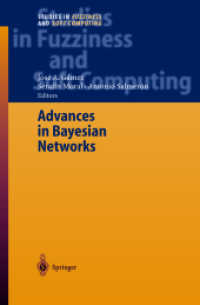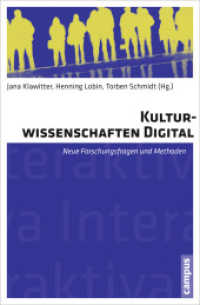Full Description
As the complexity of decision-making in medicine, and surgery in particular, is growing exponentially, this book provides a practical guide to decision-making in thoracic surgery. It offers guidance on how to select among the varied and complex approaches that new technology provides. Concise and easy to follow chapters are devoted to one or two specific questions or decisions in thoracic surgery, aiding the reader to develop their decision-making skills.
Difficult Decisions in Thoracic Surgery offers clearly formatted and evidence-based chapters to help the reader navigate the complexities of thoracic surgery. All new chapters bring insight into the challenges faced operating on the lung, esophagus, diaphragm, airway, pleaura, mediastinum, and chest wall.
The book is relevant to practicing surgeons, surgeons in training, as well as medical professionals working with thoracic diseases.
Contents
Preface.- 1. Introduction.- 2. Evidence based medicine: quality of evidence and evaluation systems.- 3. Decision analytic techniques and other decision processes.- 4. Decision Making: The Surgeon's Perspective.- 5. Involving Patients in Difficult Decisions about Having Surgery.- Part I. ERAS.- 6. Does Early Postoperative Ambulation Improve Surgical Outcomes After Lung Resection for Cancer?.- 7. Does reduction of postoperative opioid use lessen opioid dependence after lung resection for cancer?.- 8. Does carbohydrate loading improve outcomes after esophagectomy?.- 9. Is Intraoperative Fluid Restriction Effective in Reducing Complications After Esophagectomy?.- 10. Does Early Post-Operative Feeding Improve Outcomes After Esophagectomy?.- 11. Does early postoperative ambulation improve surgical outcomes after esophagectomy?.- Part II. Prehabilitation.- 12. Exercise prehabilitation and lung resection.- 13. Nutritional prehabilitation and lung resection.- 14. Prehabilitation before esophagectomy: what are the benefits of exercise?.- 15. Nutritional prehabilitation and esophagectomy.- 16. Exercise Prehabilitation and Radical Surgery for Pleural Mesothelioma.- Part III. Lung.- 17. Reducing Surgical Morbidity After Lung Resection - Effects of Smoking Cessation.- 18. High-tech intraoperative guided biopsy and robotic bronchoscopy biopsy versus wedge resection for a suspicious peripheral nodule.- 19. Which is the optimal platform for robotic-assisted diagnostic bronchoscopy?.- 20. Dye vs Fiducial Marking for Targeted Sublobar and Wedge Resection.- 21. Utility of MVO2 vs ventilatory efficiency (VE/VCO2) in assessing lung resection risk.- 22. Optimal Timing of Early-stage Lung Cancer Resection.- 23. Can wedge resection supplant segmentectomy for small peripheral NSCLC?.- 24. Does vein first hilar division improve survival after lung cancer resection?.- 25. Segmentectomy versus Lobectomy in Patients with Good Pulmonary Function - Oncologic Outcomes.- 26. Should pulmonary function evaluation be repeated after induction therapy for lung cancer prior to resection?.- 27. Does induction immunotherapy confer increased operative risk for lung resection.- 28. Wedge Resection versus Stereotactic Body Radiotherapy in Stage I Non-small Cell Lung Cancer.- 29. Salvage Resection after Definitive Radiation Therapy for Stage I Non-Small Cell Lung Cancer.- 30. Is assessment of cDNA useful in surveillance after lung cancer resection.- Part IV. Esophagus.- 31. Is mucosal eradication an effective intervention for Barrett esophagus with dysplasia?.- 32. Do oral hygiene interventions affect surgical outcomes after esophagectomy.- 33. Is Measurement of Lung Function Helpful in Assessing Risk of Esophagectomy?.- 34. Preoperative Biomarkers in Gastro-oesophageal Adenocarcinoma.- 35. Induction chemotherapy vs chemoradiotherapy for esophageal adenocarcinoma.- 36. Delayed surgical intervention after induction chemoradiotherapy for esophageal cancer.- 37. Right vs left thoracic approach for esophageal adenocarcinoma.- 38. Resection of 15 or more nodes improves survival in esophageal cancer treatment.- 39. Organ sparing therapy for locally advanced esophageal cancer.- 40. Can goals for early postoperative ambulation after esophagectomy be established?.- 41. Is EndoFLIP™ helpful in individualizing G-POEM for delayed gastric emptying after esophagectomy.- 42. Optimal Initial Therapy for Achalasia.- 43. Are Stents Good Enough for Routine Initial Therapy of Esophageal Perforation?.- 44. The utility of EndoFLIP in individualizing POEM for achalasia.- 45. Peroral Endoscopic or Open Myotomy for Zenker's Diverticulum.- Part V. Mediastinum.- 46. Does MRI contribute to the accuracy of thymoma diagnosis?.- 47. Thymectomy in the setting of synchronous pleural metastases.- 48. Pleural Metastasectomy for Regionally Disseminated Recurrence of Thymoma.- 49. Controversies in Cardiac Sympathetic Denervation for Ventricular Arrhythmias.- Part VI. Pleura.- 50. Is tPA/DNase effective routine initial therapy for pleural empyema?.- 51. Indwelling pleural catheter combined with chemical pleurodesis for the treatment of malignant pleural effusion.- 52. Survival: Pleural Resection vs Nonsurgical Management of Pleural Mesothelioma.- Part VII. Airway.- 53. Are bronchoscopic techniques sufficient for managing posttransplant bronchial stenosis?.- 54. Optimal Surgical Approach to Tracheobronchoplasty.- Part VIII. Diaphragm.- 55. Temporary Diaphragm Pacing for ICU Patients at Risk for Long-Term Ventilation.- 56. Optimal technique of phrenic nerve reconstruction for diaphragm paralysis.- 57. "The utility of paradoxical motion in selecting patients for diaphragm plication".- 58. Diaphragm Paralysis: An Open vs. Minimally Invasive Approach.- Part IX. Chest wall.- 59. Regional vs intercostal blocks for minimally invasive thoracic surgery.- 60. Optimal Duration of Nuss Bar Implant for Pectus Deformities.- 61. Intrathoracic or Extrathoracic Fixation of Rib Fractures.- Part X. Complementary medicine.- 62. A Survey of Perioperative Applications of Traditional Chinese Medicine.








